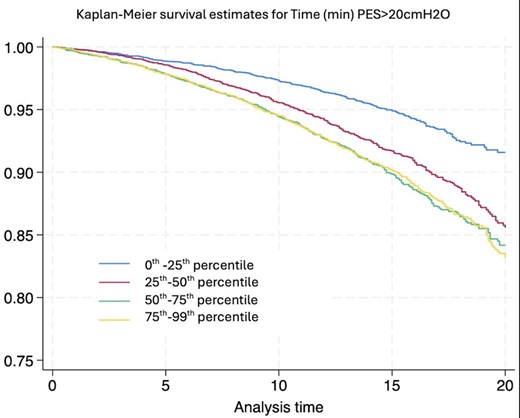-
PDF
- Split View
-
Views
-
Cite
Cite
H Nahoui, G Einvik, H Schirmer, H Hrubos-Strom, Intrathoracic pressure during sleep predicts mortality independent of comorbidities and sleep metrics, European Heart Journal. Acute Cardiovascular Care, Volume 14, Issue Supplement_1, April 2025, zuaf044.222, https://doi.org/10.1093/ehjacc/zuaf044.222
Close - Share Icon Share
Abstract
Heart failure (HF) patients suffer from increased respiratory effort at daytime demonstrated by increased negative esophageal pressure (PES)1. PES is the gold standard to estimate respiratory effort2. Its amplitudes are often used as a surrogate for intrathoracic pressure. Negative intrathoracic pressure increases left ventricle transmural pressure, left ventricle afterload and right ventricle preload3. Treatment with positive airway pressure increases reduces left ventricle preload and afterload4, but do not reduce mortality according to previous randomized controlled trials in patients with heart failure and sleep disordered breathing5.
Investigate esophageal pressure amplitudes in patients with heart failure during sleep, and long-term outcomes of increased sleep time with elevated peak to peak esophageal pressure.
16476 patients examined by overnight respiratory polygraphy (PG) with simultaneously peak to peak esophageal pressure measurement at baseline between 2003-2016. Sleep time with increased peak to peak pressure was measured in minutes at different levels of cmH2O. Demographic data and comorbidities were collected from medical records at baseline and matched with data from polygraphies. Follow up period was from baseline to 2024. Mortality data were extracted from the Norwegian death registry. Adjusted Cox proportional hazard models were used to predict mortality.
Mean age 48 years old. 26% females. Median sleep time with peak-to-peak PES>20cmH2O, at baseline, was longer in patients with HF (97.7 min compared to 59.2 min in non-HF), and it was associated with mortality at the 25th percentile (21minutes) independent of HF, sleep apnea (AHI) and nocturnal mean oxygen saturation (HR 1.298 [1.093-1.541], p0.003). Time with peak-to-peak pressure above 60 cmH2O and 80 cmH2O predicted mortality at 50th percentile (0.8 minutes) (HR 1.409 [1.206-1.647], p<0.001) and (0.2 minutes) (HR 1.384 [1.198-1.598], p<0.001) respectively.

Kaplan-Meier
Author notes
Funding Acknowledgements: Type of funding sources: Public grant(s) – EU funding. Main funding source(s): BEAMER-project.
- medical records
- airway pressure
- heart failure
- left ventricle
- obstructive sleep apnea
- right ventricle
- comorbidity
- demography
- follow-up
- sleep apnea syndromes
- esophagus
- mortality
- sleep
- treatment outcome
- ventricular afterload
- oxygen saturation measurement
- respiratory effort increased
- night time
- gold standard
- transmural
- esophageal pressure
- apnea-hypopnea index procedure
- norwegian





Comments